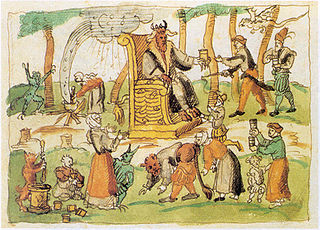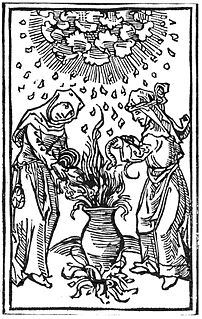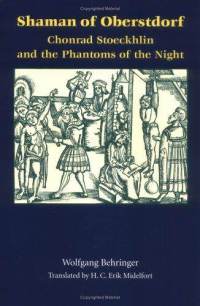Related Research Articles

The Horned God is one of the two primary deities found in Wicca and some related forms of Neopaganism. The term Horned god itself predates Wicca, and is an early 20th-century syncretic term for a horned or antlered anthropomorphic god partly based on historical horned deities.
The Roman Inquisition, formally the Supreme Sacred Congregation of the Roman and Universal Inquisition, was a system of tribunals developed by the Holy See of the Roman Catholic Church, during the second half of the 16th century, responsible for prosecuting individuals accused of a wide array of crimes relating to religious doctrine or alternative religious doctrine or alternative religious beliefs. In the period after the Medieval Inquisition, it was one of three different manifestations of the wider Catholic Inquisition along with the Spanish Inquisition and Portuguese Inquisition.

Witchcraft is the practice of what the practitioner ("witch") believes to be magical skills and abilities such as using spells, incantations, and magical rituals. Witchcraft is a broad term that varies culturally and societally, and thus can be difficult to define with precision. Historically, the most common meaning is the use of supernatural means to cause harm to the innocent; this remains the meaning in most traditional cultures worldwide, notably the Indigenous cultures of Africa and the African diaspora, Asia, Latin America, and Indigenous Nations in the Americas.
Aradia is one of the principal figures in the American folklorist Charles Godfrey Leland's 1899 work Aradia, or the Gospel of the Witches, which he believed to be a genuine religious text used by a group of pagan witches in Tuscany, a claim that has subsequently been disputed by other folklorists and historians. In Leland's Gospel, Aradia is portrayed as a messiah who was sent to Earth in order to teach the oppressed peasants how to perform witchcraft to use against the Roman Catholic Church and the upper classes.
Christian views on magic vary widely among denominations and among individuals. Many Christians actively condemned magic as satanic, holding that it opens the way for demonic possession. Some Christians simply view it as entertainment. Conversely, some branches of esoteric Christianity actively engage in magical practices.

The Witches' Sabbath is a phrase that became popular in the 20th century to denote a gathering of those considered to practice witchcraft and other rites.

Carlo Ginzburg is a noted Italian historian and proponent of the field of microhistory. He is best known for Il formaggio e i vermi, which examined the beliefs of an Italian heretic, Menocchio, from Montereale Valcellina.

Akelarre is the Basque term meaning Witches' Sabbath. Akerra means male goat in the Basque language. Witches' sabbaths were envisioned as presided over by a goat.
The benandanti were members of an agrarian visionary tradition in the Friuli district of Northeastern Italy during the 16th and 17th centuries. The benandanti claimed to travel out of their bodies while asleep to struggle against malevolent witches (malandanti) in order to ensure good crops for the season to come. Between 1575 and 1675, in the midst of the Early Modern witch trials, a number of benandanti were accused of being heretics or witches under the Roman Inquisition.

The title canon Episcopi is conventionally given to a certain passage found in medieval canon law. The text possibly originates in an early 10th-century penitential, recorded by Regino of Prüm; it was included in Gratian's authoritative Corpus juris canonici of c. 1140 and as such became part of canon law during the High Middle Ages.
Prosecutions for the crime of witchcraft reached a highpoint from 1580 to 1630 during the Counter-Reformation and the European wars of religion, when an estimated 50,000 people were burned at the stake, of which roughly 80% were women, and most often over the age of 40.
Evidence of magic use and witch trials were prevalent in the Early Modern period, and Inquisitorial prosecution of witches and magic users in Italy during this period was widely documented. Primary sources unearthed from Vatican and city archives offer insights into this phenomenon, and notable Early Modern microhistorians such as Guido Ruggiero, Angelo Buttice and Carlo Ginzburg, have defined their careers detailing this topic. In addition, Giovanni Romeo's monograph Inquisitori, esorcisti e streghe nell'Italia della Controriforma (1990) was considered pioneering and marked an important step forward in inquisitorial and witchcraft studies dealing with early modern Italy.

The witch-cult hypothesis is a discredited theory that proposes that the witch trials of the Early Modern period were an attempt to suppress a pre-Christian, pagan religion that had survived the Christianisation of Europe. According to its proponents, the witch cult revolved around the worship of a Horned God of fertility, the underworld, the hunt and the hunted, whose Christian persecutors referred to him as the Devil, and whose followers participated in nocturnal rites at the witches' Sabbath.
The Witch-Cult in Western Europe is a 1921 anthropological book by Margaret Murray, published at the height of the success of Frazer's Golden Bough. Certain university circles subsequently celebrated Margaret Murray as the expert on western witchcraft, though her theories were widely discredited. Over the period 1929-1968, she wrote the "Witchcraft" article in successive editions of the Encyclopædia Britannica.
The first historian to posit the existence of European shamanic ideas within popular beliefs of otherwise Christian Europeans was Carlo Ginzburg, who examined the Benandanti, an agrarian cult found in Friuli, Italy, whose members underwent shamanic trances in which they believed they battled witches in order to save their crops.

Between the Living and the Dead: A Perspective on Witches and Seers in the Early Modern Age is a study of the beliefs regarding witchcraft and magic in Early Modern Hungary written by the Hungarian historian Éva Pócs. The study was first published in Hungarian in 1997 as Élők és holtak, látók és boszorkányok by Akadémiai Kiadó. In 1999, it was later translated into English by Szilvia Rédey and Michael Webb and published by the Central European University Press.

Shaman of Oberstdorf: Chonrad Stoeckhlin and the Phantoms of the Night is a study of the arrest and trial of Chonrad Stoecklin (1549–1587), a German herdsman from the town of Oberstdorf who was accused and executed for the crime of witchcraft after experiencing a series of visions. Written by the German historian Wolfgang Behringer, himself a specialist in the Early Modern witch trials of Germany, Shaman of Oberstdorf was initially published in German as Chonrad Stoekhlin und die Nachtschar: Eine Geschichte aus der frühen Neuzeit by R. Piper GmbH & Co. in 1994. It was subsequently translated into English by H.C. Erik Midelfort and published in 1998 by the University of Virginia Press.

The Night Battles: Witchcraft and Agrarian Cults in the Sixteenth and Seventeenth Centuries is a historical study of the benandanti folk custom of 16th and 17th century Friuli, Northeastern Italy. It was written by the Italian historian Carlo Ginzburg, then of the University of Bologna, and first published by the company Giulio Einaudi in 1966 under the Italian title of I Benandanti: Stregoneria e culti agrari tra Cinquecento e Seicento. It was later translated into English by John and Anne Tedeschi and published by Routledge and Kegan Paul in 1983 with a new foreword written by the historian Eric Hobsbawm.

Ecstasies: Deciphering the Witches' Sabbath is a study of visionary traditions in Early Modern Europe written by the Italian historian Carlo Ginzburg. First published by Giulio Einaudi in 1989 under the Italian title Storia notturna: Una decifrazione del Sabba, it was later translated into English by Raymond Rosenthal and published by Hutchinson Radius in 1990.
Diel Breull was a German who was executed for witchcraft in Hesse in Germany.
References
- 1 2 3 Ginzburg, Carlo. Ecstasies: Deciphering the Witches' Sabbath.
- Richard Kieckheffer, Forbidden Rites: A Necromancer's Manual of the Fifteenth Century (Magic in History), page 155. Pennsylvania State University Press, February 1, 1998. ISBN 0-271-01751-1
- Carlo Ginzburg, Raymond Rosenthal (translator), Ecstasies : Deciphering the Witches' Sabbath. University Of Chicago Press, June 14, 2004. ISBN 0-226-29693-8
- Jan Peter and Yury Winterberg, Hexen - Magie, Mythen und die Wahrheit (Witches - Magic, Myths and the Truth). A documentary movie. - in German, DVD was issued on 6 April 2004
- Luisa Muraro, La signora del Gioco, Feltrinelli, Milano, 1976 - in Italian
- Mario Graziano Parri, La signora del gioco, F. Cesati, 1984. ISBN 88-7667-027-0, in Italian
- Massimo Centini, Le schiave di Diana: Stregoneria e sciamanismo tra superstizione e demonizzazione (Nuova atlantide). ECIG, 1994. ISBN 88-7545-588-0